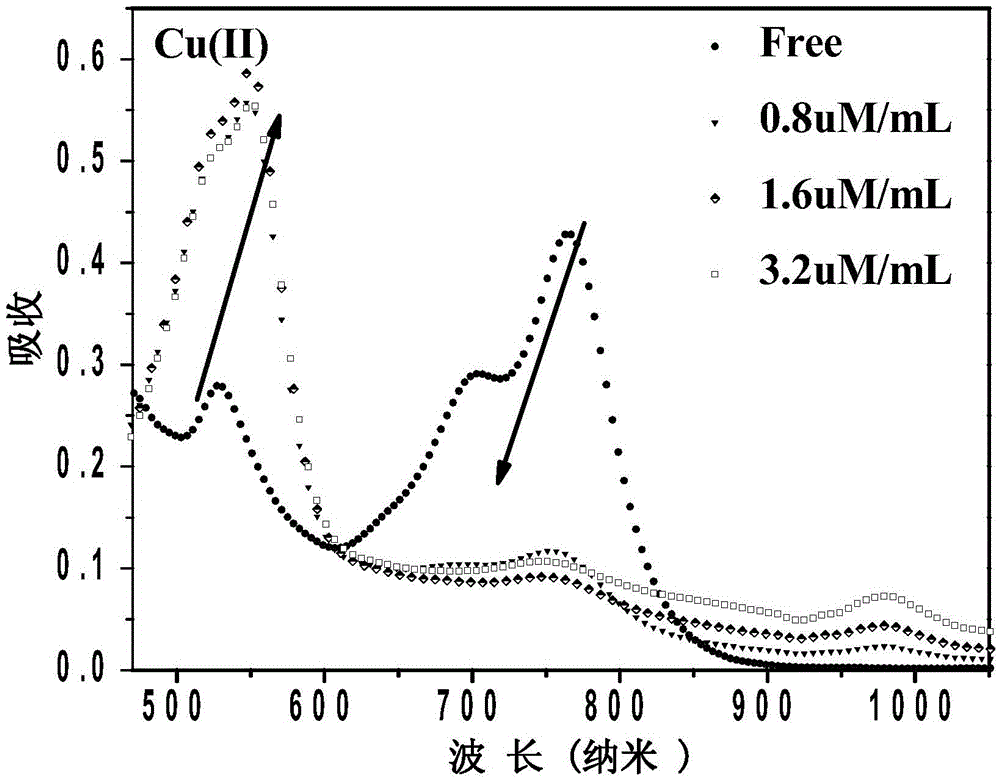Graphene oxide/perylene bisimide donor-receptor composite material and preparation method
A technology of composite material and perylene imide, which is applied in the field of organic and inorganic hybrid substances and their preparation, can solve the problems of environmental pollution and high cost, and achieve the advantages of easy-to-obtain raw materials, low price and high reaction yield Effect
- Summary
- Abstract
- Description
- Claims
- Application Information
AI Technical Summary
Problems solved by technology
Method used
Image
Examples
Embodiment 1
[0045] Add 2.14g of 3,4,9,10-perylenetetracarboxylic dianhydride (PTDA) (M=392) to the 18mL concentrated (98%) H 2 SO 4 (M=98,1.836g / mL) in a three-necked flask, vibrate with 35Hz ultrasonic for 10min, then place it on a heat-collecting thermostatic magnetic stirrer and add a condenser. After stirring at room temperature for 6h, adjust the temperature to 80 ℃, reflux reaction, add 0.053gI in the meantime 2 (M=127) As a catalyst, about 0.577 mL (3.12 g / mL) of liquid bromine (M=160) was slowly added dropwise into it using a constant pressure dropping funnel. After 24 hours of reaction, the reaction solution was diluted with distilled water to 60% concentrated sulfuric acid and filtered with suction to obtain a filter cake. The filter cake was placed in a vacuum drying oven at 90°C for 24 hours. The filter cake mainly contains the aforementioned three compounds a, b, and c, where a:b:c=7:2:1.
[0046] In a 100ml three-necked reaction flask, respectively add 0.89g bromoperylenetetrac...
Embodiment 2
[0051] Add 1.98g of 3,4,9,10-perylenetetracarboxylic dianhydride (PTDA) to 18mL concentrated (98%) H 2 SO 4 In a three-necked flask, vibrated by 35Hz ultrasonic for 10min, then put it on a heat-collecting thermostatic magnetic stirrer and add a condensing device. After stirring at room temperature for 6h, the temperature was adjusted to 80℃, and the reaction was refluxed, during which 0.052gI was added. 2 As a catalyst, about 0.58 mL of liquid bromine was slowly added dropwise into the constant pressure dropping funnel. After 24 hours of reaction, the reaction solution was diluted with distilled water to 60% concentrated sulfuric acid and filtered with suction to obtain a filter cake. The filter cake was placed in a vacuum drying oven at 90°C for 24 hours. The filter cake mainly contains the aforementioned three compounds a, b, and c, where a:b:c=7:2:1.
[0052] In a 100ml three-necked reaction flask, respectively add 0.95g of bromoperylenetetracarboxylic anhydride prepared by the...
Embodiment 3
[0057] Add 2.02g of 3,4,9,10-perylenetetracarboxylic dianhydride (PTDA) to 17mL of concentrated (98%) H 2 SO 4 In a three-necked flask, vibrated by 35Hz ultrasonic for 10min, then put it on a heat-collecting thermostatic magnetic stirrer and add a condensing device. After stirring at room temperature for 6h, the temperature was adjusted to 80℃, and the reaction was refluxed, during which 0.052gI was added. 2 As a catalyst, about 0.59 mL of liquid bromine was slowly added dropwise into the constant pressure dropping funnel. After reacting for 24 hours, the reaction solution-concentrated sulfuric acid-was diluted to 60% with distilled water and filtered with suction to obtain a filter cake. The filter cake was placed in a vacuum drying oven at 90°C for 24 hours. The filter cake mainly contains the aforementioned three compounds a, b, and c, where a:b:c=7:2:1.
[0058] Weigh 0.94 g of intermediate M1 obtained in the above step, 0.46 mL of acetic acid and 0.51 g of cyclohexylamine int...
PUM
| Property | Measurement | Unit |
|---|---|---|
| Sensitivity | aaaaa | aaaaa |
| Sensitivity | aaaaa | aaaaa |
Abstract
Description
Claims
Application Information
 Login to View More
Login to View More - R&D
- Intellectual Property
- Life Sciences
- Materials
- Tech Scout
- Unparalleled Data Quality
- Higher Quality Content
- 60% Fewer Hallucinations
Browse by: Latest US Patents, China's latest patents, Technical Efficacy Thesaurus, Application Domain, Technology Topic, Popular Technical Reports.
© 2025 PatSnap. All rights reserved.Legal|Privacy policy|Modern Slavery Act Transparency Statement|Sitemap|About US| Contact US: help@patsnap.com



